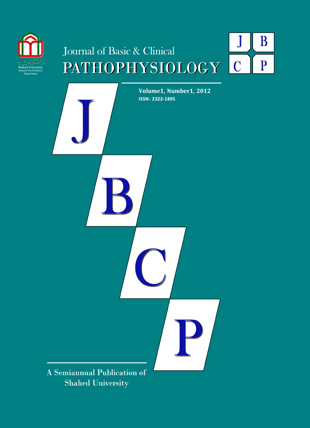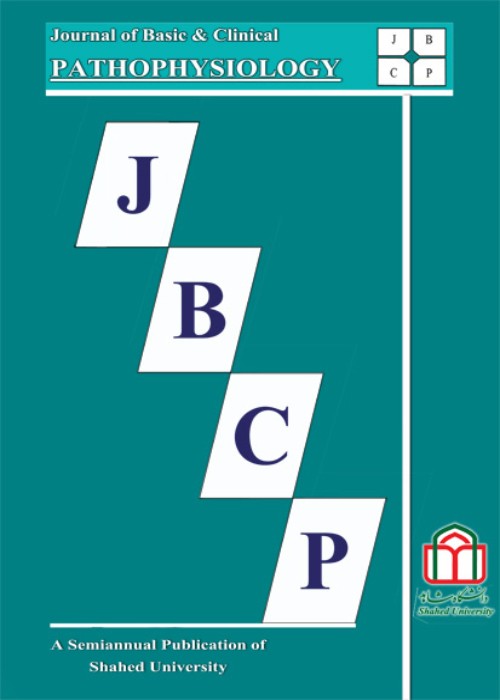فهرست مطالب

Journal of Basic & Clinical Pathophysiology
Volume:1 Issue: 1, Winter-Spring 2013
- تاریخ انتشار: 1392/02/23
- تعداد عناوین: 7
-
-
Pages 1-7Background And ObjectiveThyroid cancer is the most frequent endocrine malignancy in the world and papillary carcinoma is the most frequent thyroid carcinoma. Different markers used for determination of prognosis and VEGFR is one of them. The aim of present study was to determine the expression of Vascular Endothelial Growth Factor Receptor (VEGFR) as a prognostic marker in papillary carcinoma.Materials And MethodsThis study was conducted on 92 tissue blocks of papillary carcinoma during the period of 2009-2011 in Mostafa Khomeini Hospital, Tehran, Iran. Two tissue sections were prepared. One of them stained with Hematoxylin and Eosin and the other by immunohistochemistry to determine VEGFR expression. Also tumor size and lymph node status was determined. The data analyzed and the p-value of ≤o.o5 was considered statistically significant.ResultsThe mean age of patients was 39.32± 16.93 years. 40.2% of tumors showed VEGFR expression. 23.9% of patients had lymph node involvement. The average tumor size was 3.6 ± 2.2 cm. No meaningful relationship was observed between VEGFR expression and sex and age of patients and the size of tumor. However, there was a direct significant relationship between the absence of VEGFR expression and uninvolvement of lymph nodes.ConclusionIt seems that reduction in VEGFR expression in papillary carcinoma resulting in reduced numbers of involved lymph node and better prognosis. More complete studies in this field with patient follow up is recommended.Keywords: Papillary Carcinoma of Thyroid Gland VEGFR Tumors Size Lymph Node Involvement
-
Pages 8-15Background And ObjectiveOpposite observations about the discrepancy in the pain perception between male and female has been reported. In this regard, pain thresholds among male and female rats in different phases of oestrous cycle were evaluated via tail immersion test. In addition, efficiency of alcoholic extract of Datura stramonium as an analgesic plant in the modulation of acute pain threshold has been studied.Materials And MethodsThe control groups of male and female rats were exposed to the tail immersion test using 52˚C water. In the experimental group, the extract of Datura stramonium was injected intraperitoneally 25-30 minutes before the tail immersion test. Afterwards, in both control and experimental female rats the vaginal smear samples were taken.ResultsIn the female rats in proestrous and dioestrous phases, the pain thresholds are significantly lower than that of rats in oestrous phase (p<0.01). Also, male rats in addition to having lower pain threshold relative to whole females (p<0.05) (the average of 4 phases) treated with Datura stramonium, show a pain threshold that is significantly lower than that of females of oestrous and metoestrous phases (p<0.001). Furthermore, proestrous and dioestrous groups with lower pain thresholds relative to rats in oestrous and metoestrous phases show significant differences (p<0.001).ConclusionThe female rats in the different phases of oestrous cycle have different pain thresholds and the extract of Datura stramonium is more efficient in the pain relief of female (especially oestrous stage) than that of male rats.Keywords: Datura Stramoniu Acute pain Oestrous cycle
-
Pages 16-23Background And ObjectiveCardiovascular disorders continue to constitute major causes of morbidity and mortality in diabetic patients. In this study, the effect of chronic administration of Tribulus terrestris (TT) feeding was studied on aortic reactivity of streptozotocin (STZ)-diabetic rats and some underlying mechanisms were investigated.Materials And MethodsMale diabetic rats received TT-mixed food at a weight ratio of 6% for 7 weeks 1 week after diabetes induction. Contractile responses to KCl and phenylephrine (PE) and relaxation response to acetylcholine (ACh) were obtained from aortic rings in the presence and absence of endothelium. In addition, nitric oxide synthase inhibitor N(G)-nitro-l-arginine methyl ester (L-NAME) was used to determine the role of NO.ResultsMaximum contractile response of endothelium-intact rings to PE was significantly lower in TT-treated diabetic rats relative to untreated diabetics and endothelium removal abolished this difference. Endothelium-dependent relaxation to ACh was also significantly higher in TT-treated diabetic rats as compared to diabetic ones and pretreatment of rings with L-NAME significantly attenuated the observed response.ConclusionChronic treatment of diabetic rats with TT could prevent some abnormal changes in vascular reactivity in diabetic rats through nitric oxide in aortic tissue and endothelium integrity is necessary for this beneficial effect.Keywords: Tribulus terrestris, Diabetes mellitus, Streptozotocin, Aorta
-
Pages 24-28Background And ObjectiveRegarding side effects of acute and especially chronic inflammation and incomplete treatment of patients suffering from these side effects, the new and effective strategies are needed. For this purpose, in the present study, we scientifically evaluate an introduced folk herb Urtica dioica, for treatment of inflammation.Materials And MethodsThe Sham, control and treatment groups were subjected to four methods in order to measurement the inflammation: 1) Formalin-induced hind paw inflammation. In 2nd and 3rd methods, respectively, inflammation was induced by xylene and acetic acid application to ear and peritoneum. In the last method (chronic pain) the weight difference of cottons implanted in groin border of rats, before and after 7 days were compared in control and treatment groups.ResultsStatistical analysis has shown a significant difference between rate of inflammation in control and treatment groups. The extract in doses of 50 and 100 mg/kg could reduce inflammation produced by formalin 24.52 ± 2.2 and 22.71 ± 2.1 % respectively. However, three doses of the extract (20, 50 and 100 mg/kg) have significantly reduced the acetic acid produced peritonitis, 21.45 ± 2.4, 18.55 ± 2.2 and 27.49 ± 1.8 % respectively. Results in chronic inflammation examination showed that the extract in doses over 400 mg/kg could have diminished inflammation 24.08 ± 2.1 %.ConclusionThis study shows that alcoholic Urtica dioica extract could markedly reduce the chronic and acute inflammation.Keywords: Inflammation Urtica dioica Rats Formalin Xylene Acetic acid
-
Pages 29-36Background And ObjectiveRecent studies have shown that anticholinergic alkaloids compounds have strong analgesic effects. Due to presence of anticholinergic alkaloids in Hyoscyamus niger and its mentioned effects in Iranian traditional medicine, its analgesic effects were assessed. At first, acute and chronic pain thresholds in male NMRI rats with formalin test was evaluated, then oral and injection forms of alcoholic extract of Hyoscyamus niger seeds were assessed.Materials And MethodsMale NMRI rats weighted 300-350 g were randomly selected. Alcoholic extracts of Hyoscyamus niger seeds with 500, 1000 and 2000 mg/kg of body weight were injected intraperitoneally (10 rats per group). Also, Hyoscyamus niger seeds was prescribed orally with a proportion of 1 to 14 in their standard food to another group of rats (n=8) within 2 weeks. After all, acute and chronic pain were evaluated in control group rats (n=8) and aforementioned rats with formalin test. Moreover its analgesic effects were compared with sodium salicylate.ResultsStatistical analyses show that injection of Hyoscyamus niger seeds alcoholic extract with the mentioned dosage reduces the acute and chronic pain induced by formalin test significantly (P<0.001). Also, orally prescribed Hyoscyamus niger seeds significantly increased chronic pain threshold.ConclusionThe results of this investigation revealed that injection of Hyoscyamus niger seeds extract with the above dosages have a significant analgesic effect on acute and chronic pain thresholds. Additionally, orally prescribed only affects chronic pain in formalin test, which indicates different mechanisms of parenteral and oral on acute pain.Keywords: Pain Hyoscyamus niger seeds rats
-
Pages 37-45Background And Objective
In this research, the effect of chronic dietary soybean aqueous extract on aortic reactivity of streptozotocin (STZ)-diabetic rats was investigated.
Materials And MethodsSTZ-diabetic rats were treated with soybean aqueous extract for two months after diabetes induction. Contractile reactivity to KCl and phenylephrine (PE) and relaxation response to acetylcholine (ACh) were obtained from aortic rings and involved mechanisms were investigated.
ResultsMaximum contractile response of endothelium-intact rings to PE was significantly lower in soybean extract-treated diabetics relative to control diabetics (p
ConclusionChronic dietary treatment with soybean extract of diabetic rats attenuated some abnormal changes in vascular reactivity in diabetic rats through nitric oxide and attenuation of oxidative stress in aortic tissue.
Keywords: Key Words Soybean Diabetes mellitus Streptozotocin Aorta Nitric oxide Oxidative stress -
The effect of saffranal on intracerebroventricular strepto-zotocin-induced cognitive deficits in ratPages 46-51Background And ObjectiveIntracerebroventricular (ICV) injection of streptozotocin (STZ) causes cognitive impairment in rats. The beneficial effect of saffron main component, safranal was investigated on ICV STZ-induced learning, memory, and cognitive impairment in male rats.Materials And MethodsFor this purpose, rats were injected with ICV STZ bilaterally, on days 1 and 3 (3 mg/kg). The STZ-injected rats received safranal (60 mg/kg; i.p.) one other day starting one day pre-surgery for three weeks. The learning and memory performance was assessed using passive avoidance paradigm, and for spatial cognition evaluation, Y maze task was used.ResultsIt was found out that safranal-treated STZ-injected rats show higher correct choices and lower errors in Y maze than vehicle-treated STZ-injected rats. In addition, safranal administration significantly attenuated learning and memory impairment in treated STZ-injected group in passive avoidance test.ConclusionTherefore, these results demonstrate the effectiveness of safranal in preventing the cognitive deficits caused by ICV STZ in rats and its potential in the treatment of neurodegenerative diseases such as Alzheimer''s disease (AD).Keywords: Saffranal LStreptozotocin Learning, MemorySpatial cognition Rat


